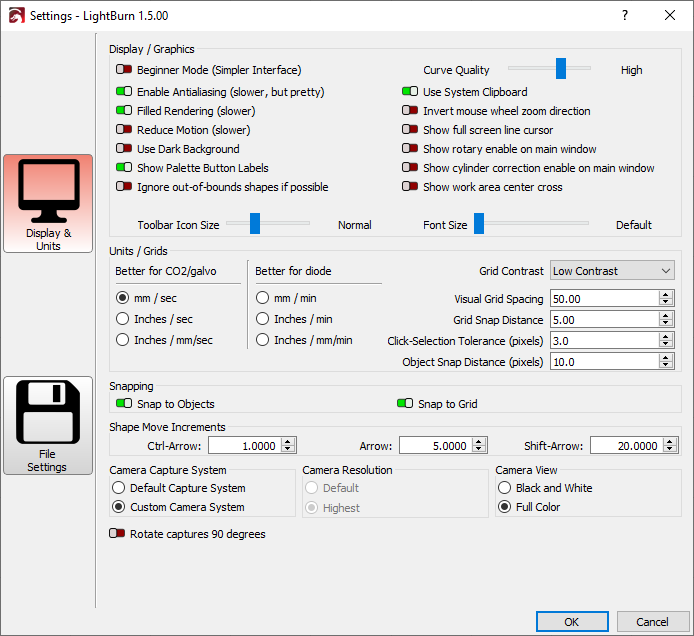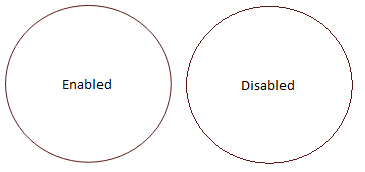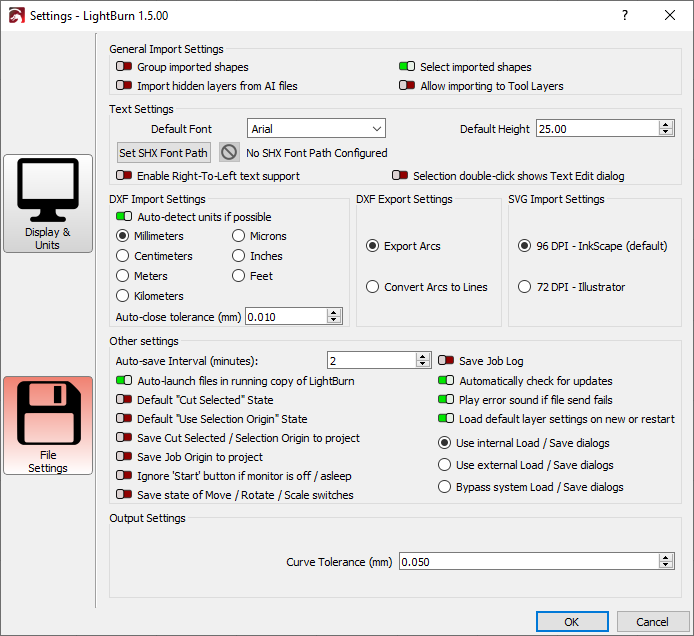This page is for the version of the Settings window present up through LightBurn 1.6. The Settings window changed significantly in LightBurn 1.7. See more on the new Settings window here.
Settings  ¶
¶
The Settings window in LightBurn controls global user preferences for LightBurn - these are the settings that apply regardless of what laser(s) you set up. These are split into two pages - Display / Units settings and File settings.
Display & Units Settings¶
The first page is the display and units settings, shown below:
Display / Graphics¶
Settings in this section control the display and presentation of LightBurn.
Beginner Mode¶
Beginner Mode simplifies the interface by removing options new users are unlikely to use. It can be turned on and off at any time from this screen. When Beginner Mode is active, you'll see the message below in the title bar.
Beginner Mode removes the following controls from the Main Window:
- Toggles for Move, Rotate, Shear and Scale at the bottom of the window
- Optimization Settings button
- Show Laser Position
- Cut Selected and Use Selection Origin
- Many of the Align Tools from the Arrangement Toolbar are replaced with the Align Helper
More Info
Although Beginner Mode can make it easier to get started, it also mean that your interface will look a little different than most video tutorials or screenshots you'll see.
If you're searching for a button or features and you don't see it, it might be because of Beginner Mode, but it could also be because you're using a machine that doesn't support the feature you're looking for. LightBurn's interface adapts to only show you the features that are compatible with your machine type.
Curve Quality¶
This controls the precision LightBurn uses in displaying curves on the screen. All curves are displayed as a series of short lines, but the higher this value is, the shorter those lines will be. You can see the difference below.
If you're working with files containing thousands of curves and your computer is lagging you may want to try reducing this value. If you need your curves to be very precise, you may want to increase it.
Enable Anti-aliasing¶
Anti-aliasing smooths the appearance of lines on your screen. Enabling anti-aliasing will make your design previews look much nicer, but does increase demand on your machine. If you notice your computer lagging, especially on older computers or when working with very complex designs, you may want to try disabling this setting.
Filled Rendering¶
When enabled, LightBurn will display filled shapes directly in the edit window. This takes longer than rendering the wire outlines, and it can hide things from you behind those filled shapes that may still be sent to the laser, so we recommend using this only for spot-checking your work, and not for general editing.
Use Dark Background¶
Shows the main edit window using a dark color scheme which may be easier on people with light sensitivity.
Show Palette Button Labels¶
This setting, enabled by default, shows numbered labels on the color palette swatches, making it easier to tell the more similar entries apart. This is also useful for users with color blindness or other vision impairments.
Use System Clipboard¶
Enabling this makes copy and paste operations slightly slower, but allows LightBurn to:
- Copy and paste across different runs of LightBurn, or between two running copies of the app
- Paste images copied from other software or web browsers
- Paste text directly into the edit window, auto-creating a text object for you
Invert mouse wheel zoom direction¶
This toggle allows users to override the scrolling behavior within LightBurn to better match their preferences for macOS or Windows.
Show full-screen line cursor¶
Draws a moving crosshair, centered on your cursor, that spans the entire edit screen.
Show work area center across¶
Draws an immovable crosshair through the center of your workspace, and spanning the entire grid.
Show Rotary Enable on Main Window¶
This adds a toggle to the main window in the Laser pane to easily confirm whether rotary is enabled or not at a glance.
Show Cylinder Correction Enable on Main Window¶
This adds a toggle to the main window in the Laser pane to easily confirm whether cylinder correction (for engraving of cylindrical objects without a rotary) is enabled or not.
Toolbar Icon Size¶
This slider allows you to manually change the scaling of icon elements in the LightBurn UI. This allows for manual overrides for HiDPI screens, UI scaling, and visually impaired users. Not all UI elements may fit on screen if increased too high.
Font Size¶
This slider allows the end user to decrease or increase the font size for LightBurn window text anywhere in the program. This allows for manual overrides for HiDPI screens, UI scaling, and visually impaired users. Not all UI elements may fit on screen if increased too high.
Info
Setting either of these sliders to be too high may result in clipping of UI elements, due to being an assumed size. If you scale them up or down such that you cannot reach the menu items to open the menu and shrink them, please use the methods listed here to reset LightBurn to the default layout.
Units & Grids¶
Inches / mm¶
LightBurn internally operates in millimeters, but can display in either millimeters or inches. Speeds can be represented as either units per second or units per minute. Users with diode lasers will likely prefer the units per minute setting, whereas CO2 lasers generally express speeds using units per second.
Grid Contrast¶
This allows you to adjust the brightness of the grid in LightBurn's main window relative to the background.
Visual Grid Spacing¶
The visual grid is set to 10 mm by default. Note that this is independent of the Grid Snap setting below.
Grid Snap Distance¶
Positioning of lines and other primitives will snap to the Grid Snap distance unless overridden using the Ctrl key. The default for this is 1 mm.
Click Selection Tolerance¶
This is how close you have to be to a line or vertex, in screen pixels, to click it. Increase this number if you have trouble selecting things, decrease it if you find yourself selecting things you didn't mean to.
Object Snap Distance¶
Controls how close, in screen pixels, your cursor has to be to an object vertex or center to engage the object snapping behavior.
Snap to Objects / Snap to Grid¶
LightBurn has two snapping behaviors which can be enabled and disabled here. Snap to Objects will snap your pointer location to the nearest object center or vertex when creating new objects, or drawing lines, making it easier to connect and align shapes. Snap to Grid will snap your cursor position to the nearest grid location, as specified by the Grid Snap value. Note that the Grid Snap and the Visual Grid do not have to be the same.
Shape Move Increments¶
When moving objects with the cursor keys in the edit window, these values control the distance to move the selection, when using the arrow keys by themselves or with the Control or Shift modifiers.
File Settings¶
General Import Settings¶
Group Imported Shapes¶
This toggle groups shapes imported from a single file together automatically, so they don't get scattered in a complex design.
Select Imported Shapes¶
This permits LightBurn to automatically select the shapes imported from a file in your editor to adjust and edit them as needed without needing to manually select them.
Import Hidden Layers from AI Files¶
When importing AI (Adobe Illustrator) files, you may want to import layers hidden in the source file for construction, design, etc. for lasering.
Allow Importing to Tool Layers¶
Enable files to be imported directly to LightBurn's tool layers.
Font Settings¶
Default Font¶
This is the font LightBurn will attempt to use for all blocks of text made with the Create Text Tool.
Default Height¶
This is the default height (in millimeters) of text LightBurn will attempt to make when using the Create Text Tool.
Set SHX Font Path¶
LightBurn allows the use of SHX fonts for single-line & quick text to laser. LightBurn will attempt to load them from the folder specified in this dialogue.
Info
It's suggested that this folder is placed in a location you can easily access, your Documents folder, where you store your LightBurn projects, etc. It is not suggested this is stored within the LightBurn application folder installed by default atC:\Program Files\LightBurn\.
Enable Right-to-Left Text Support¶
This allows LightBurn to render and utilize fonts for languages that are intended to be used right-to-left, such as Urdu.
Selection double-click shows Text Edit dialog¶
If enabled, double clicking on a text object with the selection tool active will open the text edit dialog. If disabled, or if the text tool is active, double clicking will allow you to edit the text directly in the main window.
DXF Import Settings¶
Units¶
DXF files do not store the measurement system that was used to create them. If you create an object that is 5 inches wide, it might import as 5 mm wide, because LightBurn can only see the '5'. Similarly, if your object was created in microns, it might import huge. Set this value as appropriate before importing DXF files to ensure correct scaling.
Auto Close Tolerance¶
DXF files are often saved as a collection of discrete pieces, instead of continuous paths. The Auto-Close Tolerance value tells LightBurn to connect any lines or curves that are on the same layer and closer together than this value.
Other Settings¶
Auto Save Interval¶
You can set the frequency of your auto-save by adjusting the value in minutes here. Setting the auto-save interval to 0 disables the automatic backups.
Auto-launch files in running copy of LightBurn¶
This toggle attempts to open any LightBurn project files opened on your computer within a running copy of LightBurn, rather than opening an additional copy of the program.
Save Cut Selected / Selection Origin to Project¶
This saves the cut selected and selection origin items to the file you're currently editing in, for any number of files.
Save Job Origin to project¶
This saves specific information about the origin of your job to the project. One example of a potential use is a custom origin when using a jig or fixture for your laser.
Ignore 'Start' button if monitor is off / asleep¶
This toggle prevents you from accidentally starting the laser by presing the wrong key when waking the computer. This is particularly useful on lasers that don't have enclosures with safety interlocks, such as most diode and galvo lasers.
Save state of Move / Scale / Rotate switches¶
This stores the state of the Move, Scale and Rotate switches to persist across multiple uses.
Save Job Log¶
This instructs LightBurn to save which project file was run, on what laser profile, and at what time.
Automatically check for updates¶
This permits (or denies) LightBurn the ability to automatically check for updates to itself, and inform you of them. This may be useful if your license is out of date and you want to hide the update notification.
Ignore out-of-bounds shapes if possible¶
This instructs LightBurn to not send shapes outside your work area to your laser, permitting use as a construction area.
Play error sound if file send fails¶
This produces an audible chime in the event uploading a file to a DSP controller fails.
Load default layer settings on new or restart¶
Cut settings are normally pre-filled with the last settings used for a given layer. Enable this option to reset layer settings to those previously set using the Make Default button in the Cut Settings Editor upon restarting LightBurn or starting a new project. Saved default settings are stored separately for each device profiles.
Material Libraries are also available for saving and reusing cut settings, and are recommended for users who need to store and reapply many distinct, frequently-used settings.
Use Internal Load / External Load / Bypass Load¶
These settings permit you to use non-native system dialogues to perform file/save/open operations with LightBurn. This can be useful to avoid crashing or hanging on certain programs modifying or using native dialogs.
Output Settings¶
Curve Tolerance¶
This setting is similar to the Curve Quality setting above, except that it controls the quality of output to the laser. Because it specifies the maximum amount of error allowed, the lower the value, the more accurate the curve will be. A value of 0 would be "perfect", but would create very dense data, as some lasers can only process line segments. Most users will be fine leaving this at the default value of 0.05 mm.
Technical Details
In the above image, the blue curve between the two points is the ideal shape. The black line is a straight line between them, and the red line shows the error (how far the line is from the curve). LightBurn measures this error, and if it's equal to or lower than the Curve Tolerance value, it outputs the straight line. If not, the curve is subdivided into two linear segments and the process repeats with each new segment. Those segments are shown below in violet, along with their new error values. You can see that the two new lines do a much better job of approximating the original curve.
Most people will probably never need to change this - the default is 0.05 mm, which is about ½ the width of a typical beam. Note that this is the maximum error value allowed, typical output will be better than this, and this only affects curves, not straight lines or vertices — which are exact.








